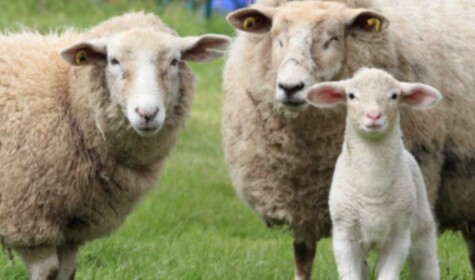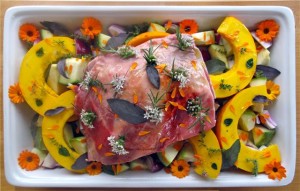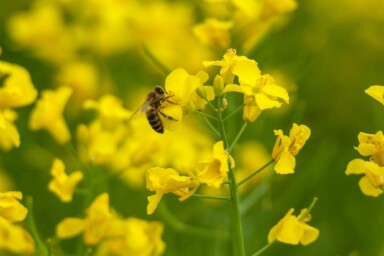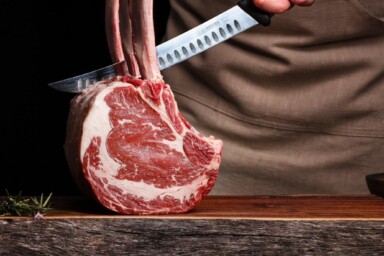We think of eating lamb at Easter in the same way as we think of turkey at Christmas. But this culinary custom is at odds with seasonal eating – most British lambs are not ready to be eaten in spring.
Indeed, they have only recently been born, hence images of fluffy lambs gamboling in fields. A spring birth is nature’s way of ensuring the lambs get grass at its freshest, sweetest and most nutritious. So the lambs fatten up in the fields and are slaughtered towards the end of summer, and the carcasses hung to bring extra taste. The best time to eat grass-fed British lamb is from autumn onwards.
When we buy spring lamb at Easter, where is it from? The likelihood is either from New Zealand, or British lambs which have not been in sniffing distance of fresh grass. Born midwinter from ewes artificially stimulated to get pregnant out-of-season, they are reared indoors on grain or concentrate – not fresh grass as nature intended.
Paul Burton, butcher at the ‘strictly seasonal’ Source Food Hall and Cafe in Bristol, says:
“Because these lambs are born in winter, they are using nutrients to keep warm, instead of going to muscle growth and laying down fat. It’s the fat that adds the flavour. So this kind of lamb is tender but a bit tasteless.”
New Zealand lambs are born in spring (which corresponds to our autumn) and reared on grass. The UK is one of the biggest importers of New Zealand lamb. However, lamb transported 11,000 miles produces a heavy carbon footprint, especially compared to locally-reared lamb. It makes economic and sustainable sense to support our own farmers. Indeed, British lamb is so much in abundance, we actually end up exporting it.
When I first telephone James Swift, of Trealy Farm, he is in the Monmouthshire farm kitchen feeding three lambs with bottled milk. James points out that the practice of getting ewes pregnant before their time has consequences: “The feed is high-cost, often imported, and keeping lambs indoors inevitably leads to greater use of antibiotics and wormers. A sheep’s fertility is naturally activated by the day’s shortening. From a traditional point-of-view, my neighbour puts ram to sheep on Guy Fawkes Day, as his father did, and his grandfather before him.”
Trealy Farm specialises in charcuterie using traditional methods of curing, smoking and air-drying, and also rears livestock traditionally, including several native sheep breeds. James says that eating lamb is a modern concept. “Lamb is not mentioned in old cookery books. Sheep were kept primarily for their wool because even an old sheep grows a new fleece each year. It would be eaten as mutton near the end of its useful life. Wool drove Britain’s economy for several centuries until colonial cotton took over the mills, and even at the start of the twentieth century, half our cheeses were from ewe’s milk.”
The lamb is an ancient religious symbol for new life – but the British only adopted it fairly recently as a festive dish, its powerful symbolism ripe for post-war marketing. As the wool industry declined, sheep farmers needed a new market. “If you look back, it seems as if industry-led initiatives deliberately created new British traditions such as the idea of eating lamb at Easter,” says James. “This helped market New Zealand lamb, then later, with cheap, subsidised grain, indoor-reared grain-fed lamb.”
Southern European peasant cultures do, however, have a tradition of eating lamb at Easter. The lamb is extremely young milk-fed and often spit-roasted with appropriate ritualistic reverence. “Milk-fed lamb is gaining in popularity in London restaurants,” observes James as he conjures with the idea of it being Trealy Farm’s next big project.
I ask James for his feasting choice at Easter. “What is in startling abundance?” he says by way of answer. “Well, the chickens have started laying again after the winter months and we have lovely fresh eggs again. What about a frittata with wild garlic, potato and bacon?”
Sheepdrove Organic Farm’s busiest time of year (after Christmas) is Easter, with customers often asking for ‘spring lamb’. Head butcher, Nick Rapps, wonders if it is a confusing term.
“Spring lamb is born around Easter-time in this country, and is only ready to be slaughtered at the end of summer when the grass has died away. Perhaps it should be called autumn lamb to prevent confusion.”
The farm pioneered mail-order organic meat, and has two butchers’ shops, in Bristol and London. At Easter, it stocks lamb born the previous April on its traditional downland farm. Nick Rapps explains: “About 10-11 months old, it is called old season lamb. New season lamb – born in winter and often raised indoors – is not as tasty. Because our old season lamb is that bit older, it has more fat which gives it more taste.”
For Easter feasting, Nick suggests ham, a (truly) traditional Easter dish, as well as hogget (‘teenage’ lamb over a year), or mutton (sheep over two years). “Hogget and mutton are tastier and more economic than spring lamb,” says Nick. “They are more mature so have more fat giving a fuller flavour. We are talking ‘good’ fat here. Research shows meat from grass-fed animals, as opposed to grain-fed, is better for you because it has more healthy unsaturated fat, and more protein.”
The trick with the cheaper cuts is to cook them more slowly. So if all this talk of lamb is making you hungry, here is Nick’s recipe for slow-roast mutton shoulder. A shoulder cut costs about £12 and will feed six – that’s about £2 a serving, says Nick.

 Insert rosemary or garlic cloves in the meat with a sharp knife, season, slosh two glasses of wine over it as it sits on its roasting tin.
Insert rosemary or garlic cloves in the meat with a sharp knife, season, slosh two glasses of wine over it as it sits on its roasting tin.




